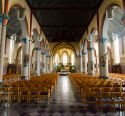Rulers and saints around Alden Biesen
This route leads you past the mighty land commandery of Alden Biesen and the abbey of Munsterbilzen. Discover what traces their influential rulers left behind in the area.
This bike tour is part of four routes designed by the network Open Churches, "Rulers and saints, Religious heritage around Alden Biesen". 28 churches and heritage buildings in Limburg open their doors to share their history, their treasures and their unique atmosphere with you. These routes take you back to the time of popular devotion, pilgrimages and hermits. You will meet the first Christians and the noble lords who designed these beautiful buildings. You will learn more about the country commanders and monastic superiors who exerted their influence far beyond the walls of their domain.
Download PDF Continue on mobile
-
Jeugdkapel – Hoeselt
At the end of the Second World War the youth movements of Hoeselt built this chapel under the leadership of the vicar Vliegen. In the back wall a large field cross has been built in with the text: 'and no one who guesses my origin or knows my destiny there' (...)
-
Prieeltje – Bilzen
In the Demerstraat you pass on your right a little chapel that has been transformed into an arbor. The gazebo was originally located in the garden of the presbytery. The grounds belonged to the Teutonic Order and the chapel was built in the 18th century by the land commander of Alden Biesen (...)
-
Sint-Mauritiuskerk – Bilzen
The neo-Gothic Sint-Mauritius church has a colourful painted interior. The pentagonal choir dates back to the Gothic period. The tombstone of Bocholtz's family was discovered under the high altar and was given a new place under the tower at the back of the church (...)
-
Landradakapel – Munsterbilzen
Lovely little chapel situated along an old road that lost its importance due to the construction of the railway in 1863 and is now a dead end. Dedicated to the Holy Landrada, the legendary founder of the Monastery of Munsterbilzen.
-
Abdij van Munsterbilzen
Legend has it that Saint Landrada founded a church dedicated to Our Lady here around 670. Around this church a women's monastery was built, which was destroyed by the Norsemen around 880 (...)
-
Onze-Lieve-Vrouw Hemelvaartkerk – Munsterbilzen
Thanks to its rich abbey history, Munsterbilzen has had several churches. However, after the French Revolution and the invasion of the French armies, they were completely destroyed, with the exception of the 16th century tower.
-
Visitors centre De Landschapsruiter – Bilzen
In 2006, during work on the N730 near the church, some rare tree trunk graves were discovered: hollow trees in which the deceased were buried. They date from the early Middle Ages (...)
-
Sint-Martinuskerk – Martenslinde
This church was founded by the abbey of Munsterbilzen. The Tenth Law was partly in the hands of the abbey and partly in those of the commandery of Alden Biesen. The Gothic choir (ca. 1400) of the old church has been preserved (...)
-
Apostelhuis – Bilzen
The impressive gatehouse of Alden Biesen was the former main entrance to the estate. The gate tower overlooks Maastricht. The gatekeeper stayed in the adjacent trumpet house. The apostle's house was originally intended as a residence for twelve needy people from the area (...)
-
Great Commandery of Alden Biesen
Alden Biesen was a country commandery of the Teutonic Order. In 1220 they received the land from Alden Biesen. This complex was at the head of a long belt of commanderies that stretched from Bekkevoort all the way to Bonn. These were accountable to the land commander, who led the complex Alden Biesen (...)



